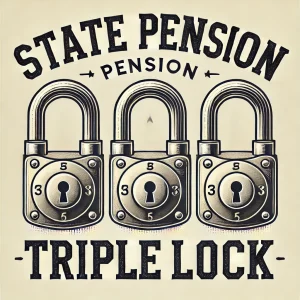
The State Pension Triple Lock is designed to protect UK pensioners from inflation and declining purchasing power. Introduced in 2011 by then-Prime Minister David Cameron, this policy ensures that the State Pension increases annually by the highest of:
- Inflation rate
- Average earnings growth
- A baseline of 2.5%
For example, if inflation reaches 10% and earnings growth is 4%, pensions increase by 10%. If both inflation and wage growth are below 2.5%, the pension still rises by 2.5%.
While this mechanism helps pensioners maintain their purchasing power, many believe it is unsustainable given the UK’s economic conditions.
The Problem With the State Pension Triple Lock
The State Pension system is already under significant financial pressure. With rising life expectancy and an aging population, the cost of maintaining the Triple Lock is increasing.
For the financial year 2023-24, the State Pension bill is £128 billion. By 2028-29, it is expected to reach £158 billion. This rapid increase has raised concerns about whether the government can afford to keep the system intact.
Critics argue that continuing the Triple Lock indefinitely could lead to a collapse of the entire State Pension system. If this happens, millions of pensioners could be left without a stable income.
Why Some Want the Triple Lock Removed
Many economists and policymakers believe that the Triple Lock must be reformed to prevent long-term economic damage. Reasons include:
- The rising financial burden on taxpayers.
- The unpredictability of high inflation, making it difficult for the government to plan future pension increases.
- A growing reliance on private pensions, reducing the necessity of a government-backed guarantee.
However, any attempt to remove or alter the Triple Lock would likely be unpopular among pensioners and voters, making it a politically sensitive issue.
What Happens if the Triple Lock Fails?
If the State Pension Triple Lock is abolished or weakened, retirees will need to rely more on private pensions. Those without additional retirement savings could face serious financial difficulties, especially if inflation continues to rise.
This is why many people in the UK already invest in private pension schemes to secure their retirement. However, for NRIs planning to retire in India, there is a better option.
Why You Should Transfer Your UK Pension to India Through QROPS
If you’ve worked in the UK but plan to retire in India, transferring your UK pension through QROPS (Qualifying Recognised Overseas Pension Scheme) can help protect your retirement funds.
Here’s why a QROPS transfer is a smart choice:
- Escape the uncertainty of the State Pension Triple Lock.
- Avoid UK taxes on pension withdrawals, including the 55% death tax.
- Invest in a rapidly growing economy, with higher fixed-income returns than the UK.
- Maintain control over your pension fund without government intervention.
As the UK pension system faces financial strain, securing your retirement savings in India through QROPS ensures stability, higher returns, and long-term financial security.
